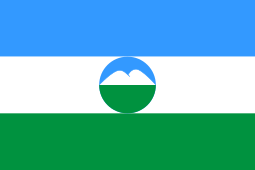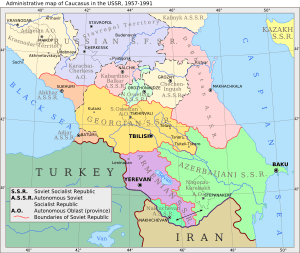Kabardino-Balkaria
The Kabardino-Balkarian Republic[14][15][16][17] (Russian: Кабарди́но-Балка́рская Респу́блика, Kabardino-Balkarskaya Respublika; Kabardian: Къэбэрдей-Балъкъэр Республикэ, Ķêbêrdej-Baĺķêr Respublikê; Karachay-Balkar: Къабарты-Малкъар Республика, Qabartı-Malqar Respublika) or Kabardino-Balkaria (Russian: Кабарди́но-Балка́рия, Kabardino-Balkariya), is a federal subject of Russia (a republic) located in the North Caucasus. As of the 2010 Census, its population was 859,939[9] on 12,500 square km. Its capital is Nalchik. The area contains the highest mountain in Europe, Mount Elbrus, at 5,642 m. Mount Elbrus has 22 glaciers that feed three rivers — Baksan, Malka and Kuban. The mountain is covered with snow year-round.
Kabardino-Balkarian Republic | |
|---|---|
| Кабардино-Балкарская Республика | |
| Other transcription(s) | |
| • Kabardian | Къэбэрдей-Балъкъэр Республикэ |
| • Karachay-Balkar | Къабарты-Малкъар Республика |
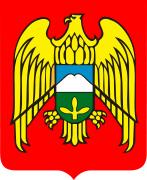 Coat of arms | |
| Anthem: State Anthem of the Kabardino-Balkarian Republic | |
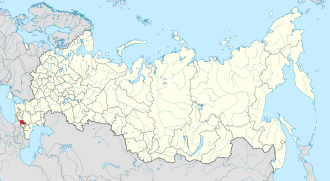 | |
| Coordinates: 43°35′N 43°24′E | |
| Country | Russia |
| Federal district | North Caucasian[2] |
| Economic region | North Caucasus[3] |
| Established | January 5, 1936[4] |
| Capital | Nalchik |
| Government | |
| • Body | Parliament[5] |
| • Head[6] | Kazbek Kokov[7] |
| Area | |
| • Total | 12,500 km2 (4,800 sq mi) |
| Area rank | 78th |
| Population (2010 Census)[9] | |
| • Total | 859,939 |
| • Estimate (2018)[10] | 865,828 (+0.7%) |
| • Rank | 59th |
| • Density | 69/km2 (180/sq mi) |
| • Urban | 54.5% |
| • Rural | 45.5% |
| Time zone | UTC+3 (MSK |
| ISO 3166 code | RU-KB |
| License plates | 07 |
| OKTMO ID | 83000000 |
| Official languages | Russian;[12] Kabardian, Karachay-Balkar[13] |
Kabardino-Balkaria includes two major ethnic communities, the Kabardins (Circassians), who speak a North-West Caucasian language, and the Balkars who speak a Turkic language. Kabardins make up the bulk of the republic's population, followed by Russians and Balkars. Other groups include Ossetians, Turks, Ukrainians, Armenians, Koreans, Chechens. According to a 2012 survey, 60% of the population adheres to Islam, 15.6% to the Russian Orthodox Church, 3% to Adyghe (Kabardian) folk religion and other indigenous faiths, and 5% are unaffiliated generic Christians. In addition, 12% of the population declares to be "spiritual but not religious".
Geography
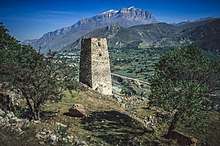
The republic is situated in the North Caucasus mountains, with plains in the northern part.
- Area: 12,500 square kilometers (4,800 sq mi)
- Borders:
- internal: Stavropol Krai (N/NE), North Ossetia–Alania (E/SE/S), Karachay–Cherkessia (W/NW)
- international: Georgia (Racha-Lechkhumi and Kvemo Svaneti) (S/SW)
- Highest point: Mount Elbrus (5,642 m)
- Maximum N->S distance: 167 kilometers (104 mi)
- Maximum E->W distance: 123 kilometers (76 mi)
Kabardino-Balkaria is traversed by the northeasterly line of equal latitude and longitude.
Rivers
Major rivers include:
- Terek River (623 km)
- Malka River (216 km)
- Baksan River (173 km)
- Urukh River (104 km)
- Chegem River (102 km)
- Cherek River (76 km)
- Argudan River
- Kurkuzhin River
- Lesken River
Lakes

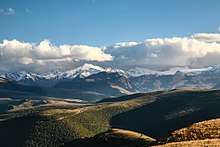
There are about 100 lakes in the Republic, none of which is large. Just over half (55) are located between the Baksan and Malka Rivers, the largest each of an area of no more than 0.01 square kilometers (0.0039 sq mi). Some of the lakes are:
- Tserikkel Lake (area 26,000 m²; depth 368 m)
- Lower Goluboye Lake
- Kel-Ketchen Lake (depth 177 m)
- Upper Tserikkel Lake (depth 18 m)
- Sekretnoye Lake
- Tambukan Lake (area 1.77 km²; depth 1.5 to 2 m), partially within Stavropol Krai.
Mountains
- Mount Elbrus (5,642 m), a volcanic mountain and the highest peak in Europe, Russia, and the Caucasus
Other major mountains include:
- Mount Dykhtau (5,402 m)
- Mount Koshtantau (5,151 m)
- Mount Shkhara (5,068 m)
- Pushkin Peak (5,033 m)
- Mount Mizhergi (5,025 m)
Natural resources
Kabardino-Balkaria's natural resources include molybdenum, tungsten, and coal.
Climate
The republic has a continental type climate.
- Average January temperature: −12 °C (10 °F) (mountains) to −4 °C (25 °F) (plains)
- Average July temperature: +4 °C (39 °F) (mountains) to +23 °C (73 °F) (plains)
- Average annual precipitation: 500–2,000 mm.
History
Germany penetrated this Area in 1942-3.
Administrative divisions
Demographics
Population
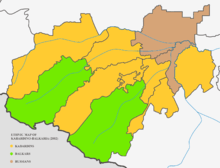
Population: 859,939 (2010 Census);[9] 901,494 (2002 Census);[18] 759,586 (1989 Census).[19]


Vital statistics
| Average population (x 1000) | Live births | Deaths | Natural change | Crude birth rate (per 1000) | Crude death rate (per 1000) | Natural change (per 1000) | Fertility rates | |
|---|---|---|---|---|---|---|---|---|
| 1970 | 592 | 11,683 | 3,913 | 7,770 | 19.7 | 6.6 | 13.1 | |
| 1975 | 634 | 12,315 | 4,717 | 7,598 | 19.4 | 7.4 | 12.0 | |
| 1980 | 680 | 14,098 | 5,457 | 8,641 | 20.7 | 8.0 | 12.7 | |
| 1985 | 725 | 15,941 | 5,854 | 10,087 | 22.0 | 8.1 | 13.9 | |
| 1990 | 772 | 15,412 | 6,573 | 8,839 | 20.0 | 8.5 | 11.5 | 2,45 |
| 1991 | 788 | 14,952 | 6,995 | 7,957 | 19.0 | 8.9 | 10.1 | 2,35 |
| 1992 | 799 | 13,728 | 7,093 | 6,635 | 17.2 | 8.9 | 8.3 | 2,16 |
| 1993 | 807 | 11,781 | 7,864 | 3,917 | 14.6 | 9.7 | 4.9 | 1,86 |
| 1994 | 816 | 11,407 | 8,052 | 3,355 | 14.0 | 9.9 | 4.1 | 1,79 |
| 1995 | 828 | 10,844 | 8,236 | 2,608 | 13.1 | 9.9 | 3.2 | 1,67 |
| 1996 | 840 | 10,293 | 8,199 | 2,094 | 12.2 | 9.8 | 2.5 | 1,56 |
| 1997 | 853 | 10,016 | 7,985 | 2,031 | 11.7 | 9.4 | 2.4 | 1,47 |
| 1998 | 866 | 9,997 | 8,201 | 1,796 | 11.5 | 9.5 | 2.1 | 1,44 |
| 1999 | 875 | 9,221 | 8,292 | 929 | 10.5 | 9.5 | 1.1 | 1,30 |
| 2000 | 883 | 9,207 | 8,792 | 415 | 10.4 | 10.0 | 0.5 | 1,26 |
| 2001 | 891 | 8,892 | 8,778 | 114 | 10.0 | 9.9 | 0.1 | 1,19 |
| 2002 | 897 | 9,119 | 8,954 | 165 | 10.2 | 10.0 | 0.2 | 1,20 |
| 2003 | 896 | 9,294 | 9,202 | 92 | 10.4 | 10.3 | 0.1 | 1,20 |
| 2004 | 889 | 9,414 | 8,695 | 719 | 10.6 | 9.8 | 0.8 | 1,22 |
| 2005 | 882 | 8,991 | 9,034 | - 43 | 10.2 | 10.2 | -0.0 | 1,13 |
| 2006 | 875 | 9,308 | 8,764 | 544 | 10.6 | 10.0 | 0.6 | 1,16 |
| 2007 | 870 | 11,397 | 8,441 | 2,956 | 13.1 | 9.7 | 3.4 | 1,41 |
| 2008 | 866 | 12,052 | 8,095 | 3,957 | 13.9 | 9.3 | 4.6 | 1,49 |
| 2009 | 863 | 12,143 | 8,406 | 3,737 | 14.1 | 9.7 | 4.3 | 1,62 |
| 2010 | 860 | 12,576 | 8,080 | 4,496 | 14.6 | 9.4 | 5.2 | 1,66 |
| 2011 | 860 | 12,848 | 8,136 | 4,712 | 14.9 | 9.4 | 5.5 | 1,70 |
| 2012 | 859 | 13,786 | 7,709 | 6,077 | 16.0 | 9.0 | 7.0 | 1,83 |
| 2013 | 859 | 13,365 | 7,712 | 5,653 | 15.6 | 9.0 | 6.6 | 1,80 |
| 2014 | 860 | 13,397 | 7,571 | 5,826 | 15.6 | 8.8 | 6.8 | 1,83 |
| 2015 | 861 | 12,627 | 7,582 | 5,045 | 14.6 | 8.8 | 5.8 | 1,75 |
| 2016 | 863 | 12,191 | 7,386 | 4,805 | 14.1 | 8.5 | 5.6 | 1,73(e) |
| 2017 | 865 | 11,092 | 7,391 | 3,701 | 12.8 | 8.5 | 4.3 | |
| 2018 | 867 | 10,786 | 6,778 | 4,008 | 12.4 | 7.8 | 4.6 |
Note: TFR 2009, 2010, 2011, 2012 source.[20]
Ethnic groups
Kabardino-Balkaria includes two major ethnic communities, the Kabardins (Circassians), who speak a North-West Caucasian language, and the Balkars who speak a Turkic language. According to the 2010 Census,[9] Kabardins make up 57.2% of the republic's population, followed by Russians (22.5%) and Balkars (12.7%). Other groups include Ossetians (1.1%), Turks (1.6%), Ukrainians (0.6%), Armenians (0.6%), Koreans (0.5%), Chechens (0.2%), and a host of smaller groups, each accounting for less than 0.5% of the total population.
| Ethnic group |
1926 Census1 | 1939 Census | 1959 Census | 1970 Census | 1979 Census | 1989 Census | 2002 Census | 2010 Census3 | ||||||||
|---|---|---|---|---|---|---|---|---|---|---|---|---|---|---|---|---|
| Number | % | Number | % | Number | % | Number | % | Number | % | Number | % | Number | % | Number | % | |
| Kabarday | 122,237 | 54.2% | 152,237 | 42.4% | 190,284 | 45.3% | 264,675 | 45.0% | 303,604 | 45.5% | 364,494 | 48.2% | 498,7022 | 55.3% | 490,453 | 57.2% |
| Balkars | 33,197 | 14.7% | 40,747 | 11.3% | 34,088 | 8.1% | 51,356 | 8.7% | 59,710 | 9.0% | 70,793 | 9.4% | 104,951 | 11.6% | 108,577 | 12.7% |
| Russians | 32,622 | 14.5% | 129,067 | 35.9% | 162,586 | 38.7% | 218,595 | 37.2% | 234,137 | 35.1% | 240,750 | 31.9% | 226,620 | 25.1% | 193,155 | 22.5% |
| Ossetians | 3,839 | 1.7% | 4,608 | 1.3% | 6,442 | 1.5% | 9,167 | 1.6% | 9,710 | 1.5% | 9,996 | 1.3% | 9,845 | 1.1% | 9,129 | 1.1% |
| Ukrainians | 24,723 | 11.0% | 11,142 | 3.1% | 8,400 | 2.0% | 10,620 | 1.8% | 12,139 | 1.8% | 12,826 | 1.7% | 7,592 | 0.8% | 4,800 | 0.6% |
| Others | 8,803 | 3.9% | 21,328 | 5.9% | 18,315 | 4.4% | 33,790 | 5.7% | 47,246 | 7.1% | 55,672 | 7.4% | 53,784 | 6.0% | 51,556 | 6.0% |
| 1 The results of the 1926 census refer to the present territory, which is a combination of the Kabardo-Balkarian AO and a part of the Terek district. The latter area was mainly inhabited by Russians and Ukrainians.[21]
2 In view of the results of the 1989 census and the 2010 census, the number of Kabardins in 2002 seems unlikely high. 3 2,269 people were registered from administrative databases, and could not declare an ethnicity. It is estimated that the proportion of ethnicities in this group is the same as that of the declared group.[22] | ||||||||||||||||
Religion
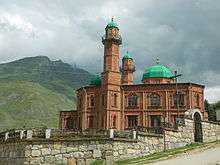
According to a 2012 survey which interviewed 56,900 people,[23] 60% of the population of Kabardino-Balkaria adheres to Islam, 15.6% to the Russian Orthodox Church, 3% to Adyghe (Kabardian) folk religion and other indigenous faiths, 5% are unaffiliated generic Christians. In addition, 12% of the population declares to be "spiritual but not religious", 5.4% is Atheist or follows other religions including Jehovah’s Witnesses.[23]
Politics
The head of government in Kabardino-Balkaria is the Head. The current Head is Kazbek Kokov.[25]
The legislative body of the Republic is the Parliament comprising 72 deputies elected for a five-year term.[5][26]
See also
- Caucasian Avars
- Bulgars
- List of the Chairmen of the Parliament of the Kabardino-Balkarian Republic
- Minor hydro-electric plants of Kabardino-Balkaria
- Mount Imeon
References
Notes
- Law #13-RZ
- Президент Российской Федерации. Указ №849 от 13 мая 2000 г. «О полномочном представителе Президента Российской Федерации в федеральном округе». Вступил в силу 13 мая 2000 г. Опубликован: "Собрание законодательства РФ", No. 20, ст. 2112, 15 мая 2000 г. (President of the Russian Federation. Decree #849 of May 13, 2000 On the Plenipotentiary Representative of the President of the Russian Federation in a Federal District. Effective as of May 13, 2000.).
- Госстандарт Российской Федерации. №ОК 024-95 27 декабря 1995 г. «Общероссийский классификатор экономических регионов. 2. Экономические районы», в ред. Изменения №5/2001 ОКЭР. (Gosstandart of the Russian Federation. #OK 024-95 December 27, 1995 Russian Classification of Economic Regions. 2. Economic Regions, as amended by the Amendment #5/2001 OKER. ).
- USSR. Administrative-Territorial Divisions of the Union Republics, p. 35
- Constitution of the Kabardino-Balkarian Republic, Article 91
- Constitution of the Kabardino-Balkarian Republic, Article 78
- Official website of the Head of the Kabardino-Balkarian Republic. Biography Archived October 28, 2014, at the Wayback Machine (in Russian)
- Федеральная служба государственной статистики (Federal State Statistics Service) (May 21, 2004). "Территория, число районов, населённых пунктов и сельских администраций по субъектам Российской Федерации (Territory, Number of Districts, Inhabited Localities, and Rural Administration by Federal Subjects of the Russian Federation)". Всероссийская перепись населения 2002 года (All-Russia Population Census of 2002) (in Russian). Federal State Statistics Service. Retrieved November 1, 2011.
- Russian Federal State Statistics Service (2011). "Всероссийская перепись населения 2010 года. Том 1" [2010 All-Russian Population Census, vol. 1]. Всероссийская перепись населения 2010 года [2010 All-Russia Population Census] (in Russian). Federal State Statistics Service.
- "26. Численность постоянного населения Российской Федерации по муниципальным образованиям на 1 января 2018 года". Federal State Statistics Service. Retrieved January 23, 2019.
- "Об исчислении времени". Официальный интернет-портал правовой информации (in Russian). June 3, 2011. Retrieved January 19, 2019.
- Official throughout the Russian Federation according to Article 68.1 of the Constitution of Russia.
- Constitution of the Kabardino-Balkarian Republic, Article 76
- "Head of Kabardino-Balkarian Republic reported to the President on the situation in Mount Elbrus region". President of Russia. Retrieved February 17, 2020.
- "Russia's federal constituent entities". Federation Council of the Federal Assembly of the Russian Federation. Retrieved February 17, 2020.
- Skutsch, Carl (November 7, 2013). Encyclopedia of the World's Minorities. Routledge. ISBN 978-1-135-19388-1.
- "Territorial divisions of the MIA of Russia". en.mvd.ru. Retrieved February 17, 2020.
- Russian Federal State Statistics Service (May 21, 2004). "Численность населения России, субъектов Российской Федерации в составе федеральных округов, районов, городских поселений, сельских населённых пунктов – районных центров и сельских населённых пунктов с населением 3 тысячи и более человек" [Population of Russia, Its Federal Districts, Federal Subjects, Districts, Urban Localities, Rural Localities—Administrative Centers, and Rural Localities with Population of Over 3,000] (XLS). Всероссийская перепись населения 2002 года [All-Russia Population Census of 2002] (in Russian).
- "Всесоюзная перепись населения 1989 г. Численность наличного населения союзных и автономных республик, автономных областей и округов, краёв, областей, районов, городских поселений и сёл-райцентров" [All Union Population Census of 1989: Present Population of Union and Autonomous Republics, Autonomous Oblasts and Okrugs, Krais, Oblasts, Districts, Urban Settlements, and Villages Serving as District Administrative Centers]. Всесоюзная перепись населения 1989 года [All-Union Population Census of 1989] (in Russian). Институт демографии Национального исследовательского университета: Высшая школа экономики [Institute of Demography at the National Research University: Higher School of Economics]. 1989 – via Demoscope Weekly.
- http://www.gks.ru/wps/wcm/connect/rosstat_main/rosstat/ru/statistics/publications/catalog/doc_1137674209312
- http://www.ethno-kavkaz.narod.ru/rnkbr.html
- http://www.perepis-2010.ru/news/detail.php?ID=6936
- "Arena: Atlas of Religions and Nationalities in Russia". Sreda, 2012.
- 2012 Arena Atlas Religion Maps. "Ogonek", № 34 (5243), 27/08/2012. Retrieved 21/04/2017. Archived.
- Путин опять увольняет губернаторов, а на их место назначает однофамильцев или бывших губернаторов. А-а-а! Как не запутаться? Вот шпаргалка. Meduza (in Russian). Retrieved September 26, 2018.
- Constitution, Article 94.
Sources
- Совет Республики Парламента Кабардино-Балкарской Республики. Закон №13-РЗ от 4 августа 1994 г. «О государственном гимне Кабардино-Балкарской Республики», в ред. Закона №13-РЗ от 13 апреля 2015 г «О внесении изменений в статьи 2 и 4 Закона Кабардино-Балкарской Республики "О государственном гимне Кабардино-Балкарской Республики"». Вступил в силу 18 августа 1994 г. Опубликован: "Кабардино-Балкарская правда", №148, 12 августа 1994 г. (Council of the Republic of the Parliament of the Kabardino-Balkarian Republic. Law #13-RZ of August 4, 1994 On the State Anthem of the Kabardino-Balkarian Republic, as amended by the Law #13-RZ of April 13, 2015 On Amending Articles 2 and 4 of the Law of the Kabardino-Balkarian Republic "On the State Anthem of the Kabardino-Balkarian Republic". Effective as of August 18, 1994.).
- Парламент Кабардино-Балкарской Республики. №28-РЗ 1 сентября 1997 г. «Конституция Кабардино-Балкарской Республики», в ред. Закона №40-РЗ от 19 октября 2015 г. «О поправках к Конституции Кабардино-Балкарской Республики». Вступил в силу со дня официального опубликования. Опубликован: "Кабардино-Балкарская правда", №177, 9 сентября 1997 г. (Parliament of the Kabardino-Balkarian Republic. #28-RZ September 1, 1997 Constitution of the Kabardino-Balkarian Republic, as amended by the Law #40-RZ of October 19, 2015 On the Amendments to the Constitution of the Kabardino-Balkarian Republic. Effective as of the day of the official publication.).
- Дударев, В. А.; Евсеева, Н. А. (1987). И. Каманина (ed.). СССР. Административно-территориальное деление союзных республик (in Russian). Moscow.
External links
| Wikimedia Commons has media related to Kabardino-Balkaria. |
